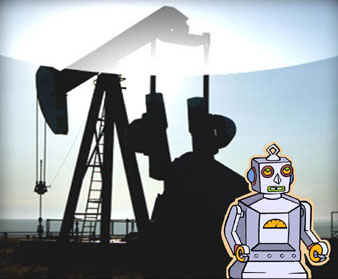
Machine Chat (Or, I, Drill Head)
By Thursday Review staff | published Tuesday, January 28, 2014 |
Earlier this month Thursday Review writer Earl Perkins wrote about a plan by farmers in California and other states to begin using mobile, preprogrammed robots to harvest lettuce and other crops. Aside from the obvious ethical and economic concern—thousands of unemployed agricultural workers—the intriguing flipside was that an unpleasant manual labor task could be eliminated completely.
But what would happen if machines operating remotely in the field—oil wells, drilling mechanisms, water pumps, harvesters, irrigation systems, cattle gates—could be given dynamic, real-time instructions by a computer, laptop or, better still, by a handheld device like a smart phone?
Verizon Wireless is already investing in technologies that may be the answer to that question. Verizon is in the early testing stages of a system called M2M (Machine-to-Machine) which will allow precisely the sort of unencumbered chat between hardware that in the recent past would have been the stuff of the sci-fi of Isaac Asimov.
In fact, machine-to-machine technologies already exist in widespread, common ways, most especially in cities and suburbs, and the list of examples could fill books, from home security systems, fire control systems and residential door lock applications (have you ever left home and then thought to yourself, did I close the garage door?), to the elaborate systems now routinely used by companies like GM and Ford to build cars and trucks, to the vast interconnections between power companies who work shoulder-to-shoulder on the world’s power grid.
But what about in those vast rural spaces of places Oklahoma, Wyoming, Colorado, Montana or Nebraska, where there is scant high speed internet penetration but a density of expensive machines for drilling, harvesting and ranching? What about those broad spaces required for high tech wind turbines?
Verizon is using cell phone towers in Montana to test precisely that theory. The wireless giant has already added dozens of new towers across the Big Sky State as part of their rollout of technologies designed to allow someone at a location, perhaps hundreds of miles away, to directly manage drill heads and oil wells from laptops and smartphones. For Verizon’s purposes, the oil and gas industry is as good a place to start, since many sites are located so far off the internet and landline grid that they can only be reached by dirt roads. Advanced cell tower coverage can close that geographical gap, and give supervisors direct, real-time access to the machines in the field.
Add to the mix the use of video monitoring and GPS devices—once prohibitively expensive but now easily within reach—and Verizon hopes to create a specialized network for farmers, ranchers, energy companies and others who have valuable hardware and machines in hard-to-reach locations, or spread out across vast farms or fields.
So, to you oil workers, ranchers and farmers, find an old paperback copy of Asimov's I, Robot and learn those “Three Laws of Robotics.”
Related articles in Thursday Review:
The Salad Robots; Thursday Review; by Earl Perkins; January 8, 2014.
T-Mobile & Verizon: Fewer Dropped Calls; Thursday Review; by R. Alan Clanton; January 6, 2014.
